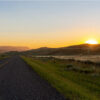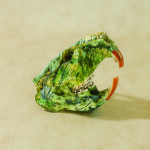By Emilene Ostlind
“For many Americans, the open road best captures the essential character of the West—unfinished, open-ended, a marriage of the human psyche with the earth, sky, and highway.” —William Wyckoff, Geographer
We’ve all been there, driving fast on a ribbon of asphalt, watching a distant thunderhead boil up, counting raptors on fenceposts, cresting a long geologic uplift only to have the last FM station flicker to static. These roads of the West mean everything to us, linking our scattered towns and cities with the most remote ranches and energy fields, carrying goods and newspapers, food and medicine, letters and visitors. We need our roads. We take our roads for granted, forgetting how extensively they shape our existence. And we curse our roads when they are clogged with construction or sheathed in deadly ice.
Like any human-built infrastructure, roads also change the places they cross. In the last few decades, researchers and ecologists have begun to look carefully at the ways roads disrupt natural systems. We open this issue with an introduction to the Western Transportation Institute, a research unit based at Montana State University in Bozeman, to illustrate the cutting-edge ways road ecologists are scrutinizing roadway impacts and devising solutions to mitigate the damages they cause.
Some of the damage is apparent, marked with legions of bloody wild animal carcasses, small and large, smacked by speeding vehicles. Other influences are more subtle, such as the way roads alter wildlife behavior even when the animals aren’t struck. The more we learn, the better we can do to blunt the harsh disruptions roads bring to our wild lands. For example, ecological datasets can inform ways to divert new roads around fragile natural areas. One simple way to mitigate road damage is to reduce speed limits, especially at certain times of day or year when animals are most susceptible. Researchers and highway managers are even designing crossing structures to safely ferry wild animals over or under roadways. In the case of massive Interstate 80, which acts like a wall across hundreds of miles of big game habitat in southern Wyoming, new wildlife crossing structures might begin to stitch a broken landscape back together. Of course, as one researcher in this issue puts it, “Not building new roads is the number one conservation action.”
This exploration into the field of road ecology took us in some less-expected directions, too. You’ll find an essay about a highway engineer and his care in designing roads through the desert he loved. And you’ll join an adventurer who explores abandoned mining roads by mountain bike and discovers something other than the ruined industrial site she expected. Roads are part of our human experience on the landscapes where we dwell. Even as they disrupt wild places, they also mediate our connections to the land, indeed linking our psyches to the earth and sky.


